Don’t ask me why dragon fruit is called dragon fruit. When I think about a Dragon fruit, I imagine a tiny dragon hanging by the tail on a large tree. Though if dragon fruit really was like that, ASPCA wouldn’t let people eat it. Dragon fruit is, in reality, a member of the cactus, or Cactaceae family. It makes a delicious fruit, and is totally worth growing.
I recently went to a demonstration by a local Chinese agricultural research station on pollinating and growing dragon fruit. It was very informative and useful, so I took notes and put together this article.
Propagating Dragon Fruit
Dragon fruit can be started either by cuttings or by seed. Starting by cuttings is the best, because they grow and fruit faster than seedlings do. To take dragon fruit cuttings, cut a newer piece of growth off of a dragon fruit plant. It should be about six to eight inches long. Then, at the bottom inch, cut all three ridges to expose the fibrous middle.
Leave the cutting to air-dry for seven days. Do not put it in water or water it at all during that time. When seven days is over, plant your dragon fruit cutting into a pot or directly into the ground. In about half a month it roots into the soil. If you started it in a pot first, you can transplant it into the soil after half a month. From a cutting, dragon fruit takes fourteen months to fruit in tropical climates from cuttings.
Climate
Dragon fruit thrives in hot, dry places. It is suitable for ridges, but can also be grown lower down. It loves full sun and cannot take freezing weather.
Support Methods for Dragon Fruit
Dragon fruit needs support to climb up. It can also climb up a tree, but it is harder to harvest. The Chinese near us are using a style of welded support column with a ring at the top that allows dragon fruit to scramble up through the middle then tumble over.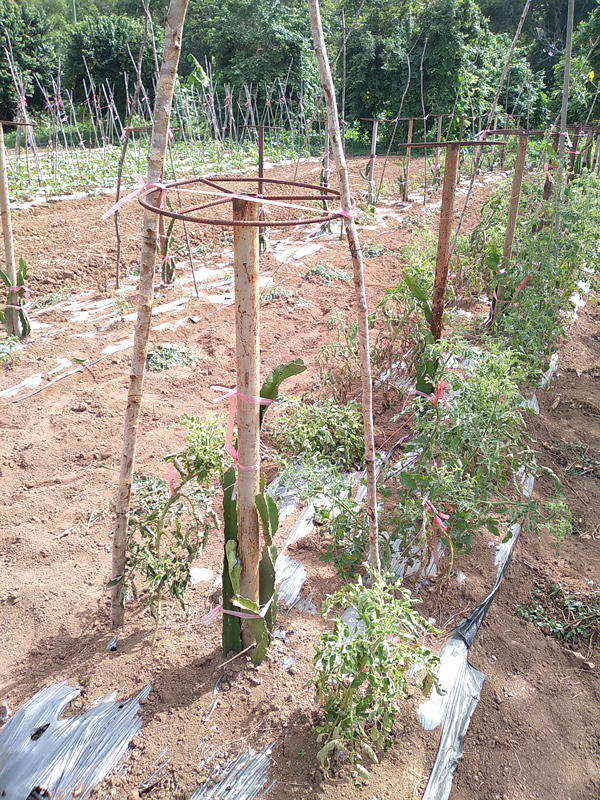 There is also a method of running two parallel bars along a row of dragon fruit. The Chinese call this style a bow support.
There is also a method of running two parallel bars along a row of dragon fruit. The Chinese call this style a bow support. 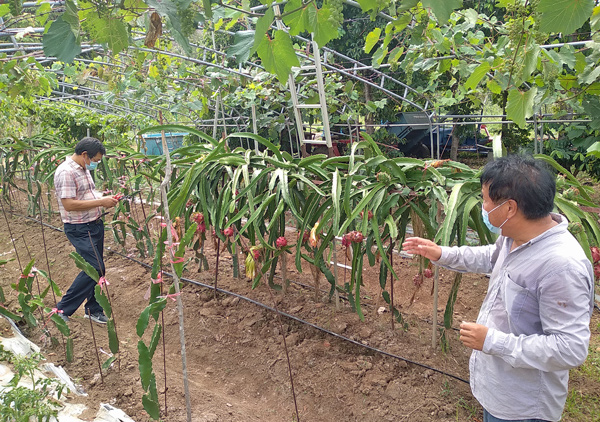
The idea is simply to keep the dragon fruit plants accessible for care, pollination and harvesting. There are some more good ideas here.
You could also weld one or you could hire a welder to make you a basic support. We are having a local welder make some supports for our dragon fruit.
Pollinating Dragon Fruit
Dragon fruit flower all year around in the tropics. Their flowers are very large, beautiful and fragrant. The blooms only open up at night from 9:00 P.M to 6:00 A.M. They fruit better and make larger fruit if they are hand pollinated. All you need to do this is a paint brush or a q-tip.
Any time after 9:00 P.M, go out to your dragon fruit plant. Hold the bloom carefully, and take the pollen off of the flower’s anthers with a q-tip or a paintbrush. Then put the pollen onto the stigma. Hand pollinating dragon fruit is very simple and worthwhile, as it takes the risk out of the process and ensures good fruit set. It takes a little more than a month for the fruit to be ready after pollination.
Harvesting Dragon Fruit
Dragon fruit is ready when it is bright red and shiny. To eat, simply pick it, cut it in half, and eat the inside with a spoon.
After the presentation on dragon fruit at our local Chinese Research Station, we were given some young dragon fruit plants to grow ourselves. Will you be growing dragon fruit too?
Note: You can learn more about how to propagate almost everything in Free Plants for Everyone: The Good Guide to Plant Propagation.

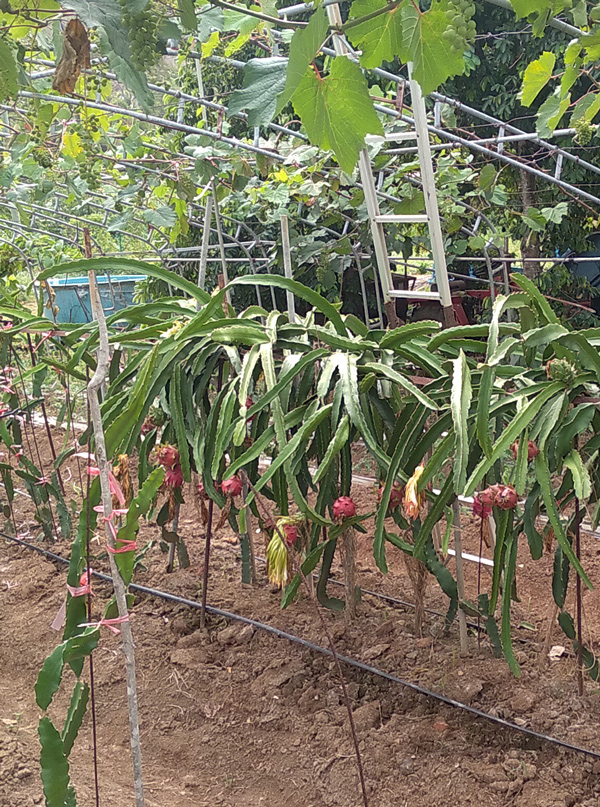
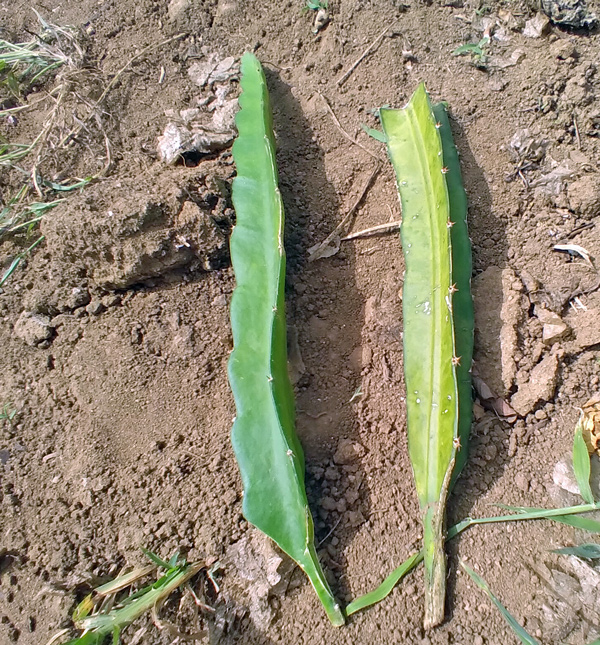
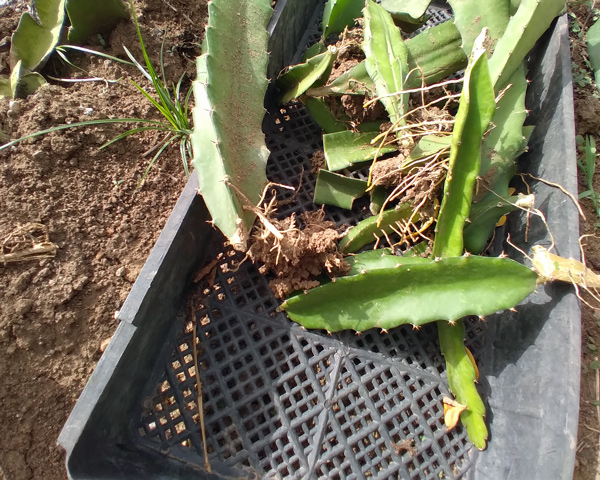
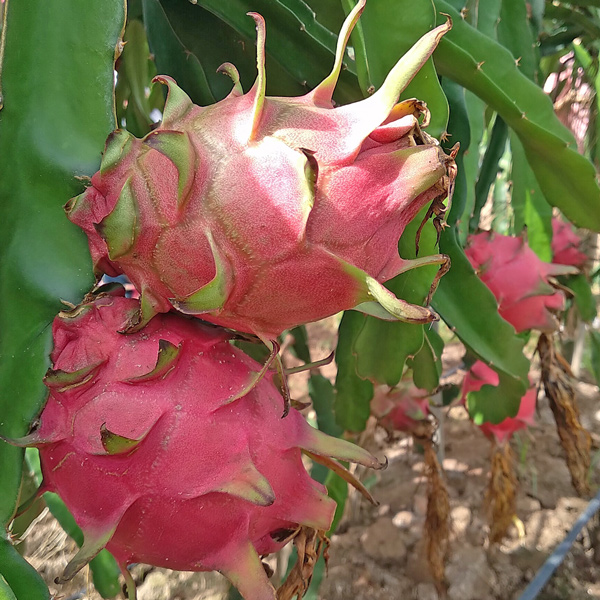
8 comments
Thank you so much for this article, we are just learning about dragon fruit, my daughter has one so far. This was very well written, thank you, Daisy, I hope you keep writing : ) I went to the three acres paradise to see their supports, good plan, good pics, but they planted theirs in a shady area…I wonder how they will do. Ah, the fun of seeing how many ways to grow our food. Happy Independence Day, may God bless you.
Thanks, Elizabeth! I hope your daughter’s dragon fruit grows well.
Thank you so much for sharing Daisy! I had a couple of cuttings on pots that grew long, and I had just trimmed them and have many cuttings, wondering how to plant them in the ground. Your article answered most of my questions. I don’t have much space in my backyard. There’s this one planter that gets sun in the late morning through the afternoon. Is that a good place to plant them? Thank you!
Am interested. In growing of the dragon fruit in Isinya Kajiado county.
Thank you very much for this interesting, informative and instructive article. I received a cutting and left it out in the rainy weather. I immediately followed your instructions and change the process.
Thank you Daisy, for a simple but informative read ;)
I only missed the visual on where exactly the flower “parts” are for hand pollination. Guess I could look it up. Lol My step mother grows 3 varieties of dragon fruits in Santa Ana, CA. They are very prolific and she’s given me several cutting. I’ve had 3 blooms and 2 fruits in 15 years so guessing it’s too cool in Northern California. Will try again. Th thanks for inspiring me ❣
[…] The survival gardener […]
[…] How to Grow Dragon Fruit: From Propagation To Harvest https://cyberleninka.org/article/n/275028 https://www.researchgate.net/publication/350133783_Dragon_fruit_A_review_of_health_benefits_and_nutrients_and_its_sustainable_development_under_climate_changes_in_Vietnam […]
Comments are closed.